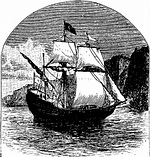Palisades Celebrates Hudson’s Quadricentennial
The year 2009 marks the 400th anniversary of Henry Hudson’s voyage of exploration of the Hudson River. The Palisades Historical Committee and the Palisades Free Library celebrated this milestone with a weekend of special events.
On Saturday, September 12, about 50 people attended a program at the Palisades Free Library which began at 2:00 pm and explored the past history of the community as it related to the Hudson River. Displays gave information about the Native Americans of this area, Hudson’s voyage, the Snedens Landing Ferry, and boat-building on the Hudson. Artifacts excavated at Skunk Hollow and found along the river shore were exhibited, as well as a map showing the extent of the river from its origin to its mouth in New York harbor. Lemonade and home-made cookies were served. But the highlights of the afternoon were the talks given by Bill Knudson, Lee Sneden, and Don Finck about their experiences with boats on the river.
Bill Knudson, now 93 years old, built his first boat, a 14-foot scow, around 1930 and rowed and sailed it up and down the river with two friends. Later he built an ice boat – there was more ice on the river in those days — from two Flexible Flyers sleds with boards in between, but it disintegrated on its first voyage. Bill remembers sailing faster than he had ever sailed before it fell to pieces.
Lee Sneden, who grew up here and was a teenager in the 1940’s, fished and crabbed, sailed and rowed the river with his friend Bev Walden. One day they rescued from the Hudson a couple who had been visiting Laurence Olivier and tipped over in Olivier’s boat the Fiddle-Dee-Dee, but they were barely thanked, which still bothers Lee 60 years later. Lee and Bev used to help the fisherman Charlie Garrison, who lived in a shack down at the shore, bring in his fishing nets and in exchange he let them use some of his many boats. Lee also gave us glimpses of the community in those long-ago days. The last speaker was Don Finck who described his experiences with power boats and fishing on the Hudson, often with Bernie Doyle and Ken McNichols. At the beginning of his fishing career, he and his father Arnold caught a large catfish and had a difficult time getting the hook out of its mouth; Arnold, who was not a fisherman, was bleeding by the time they finally succeeded.
On Sunday, September 13 at 3:00 pm, Palisadians were invited to the Esplanade to hear Professor Charles Stark from Marist College give a talk on “The Mystery of Hudson’s Voyage of Discovery.” The timing was perfect — it was 400 years ago to the day that Hudson sailed past our community on his voyage up-river.
Hudson, hired by the Dutch to search for a northeast passage to Asia, began his voyage in Amsterdam in April 1609. He first sailed north to Scandinavia but then, for an unknown reason, reversed course and set a course first west and then south as far as Virginia. This was the first mystery of Hudson’s voyage. He was not lost; he had good maps and charts, but he had apparently abandoned his original intention. From Virginia he sailed north along the coast, looking for a northwest passage. The Delaware River was too shallow but he arrived at the mouth of the Hudson on September 4. On September 9 he headed up-river, spending the next two weeks exploring the Hudson. After reaching a point north of Catskill where the river was too shallow to proceed, he reversed course and sailed downriver. He left for England on October 4, arriving in November. Why he sailed to England instead of Amsterdam is another mystery.
Our information about the voyage comes from the journal kept by the Half-Moon’s mate Robert Juet. Professor Stark’s audience enjoyed the talk and asked many questions.



